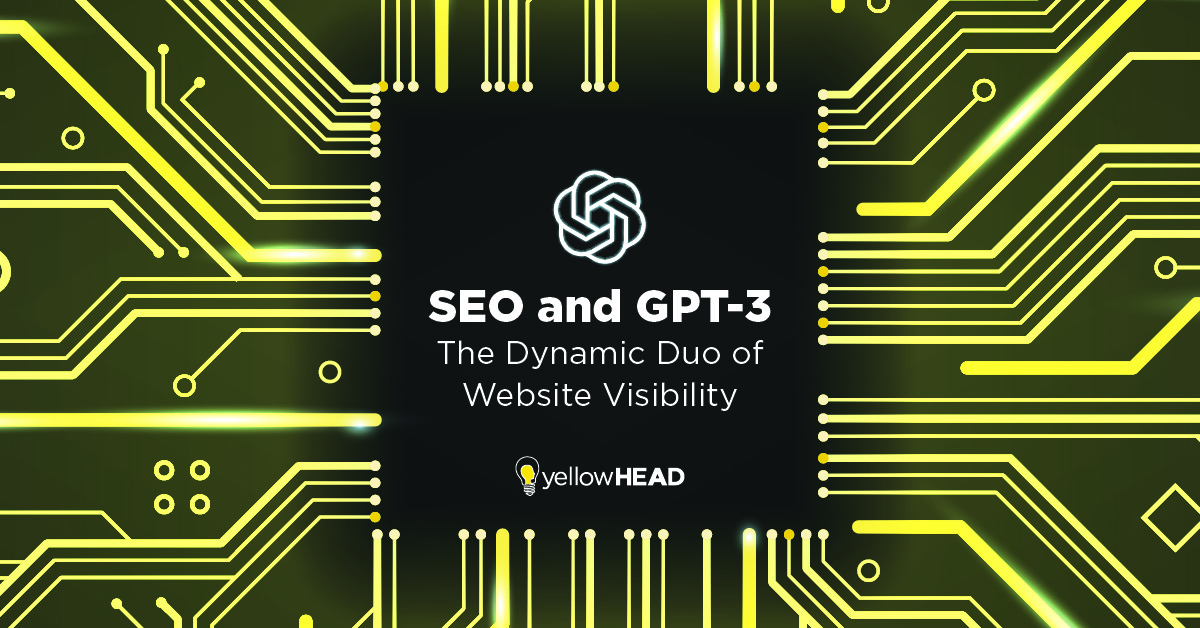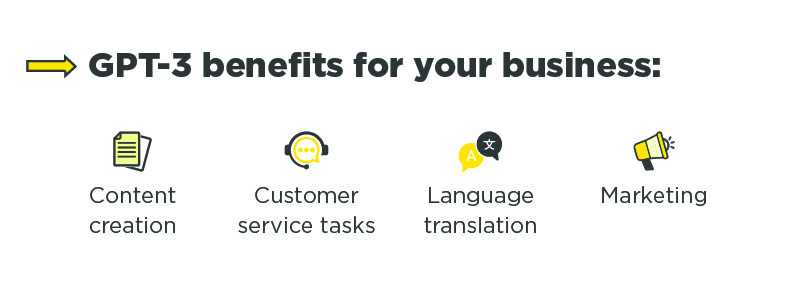SEO and GPT-3: The Dynamic Duo of Website Visibility
Search Engine Optimization (SEO) and language models like GPT-3 (chatGPT) can seem like mutually exclusive solutions for improving website visibility, but in reality, they complement each other in different ways.
Table of Contents
- What is GPT-3 AI?
- How does GPT-3 work?
- How can I use GPT-3 for my business?
- Can You Use GPT-3 for SEO
- The meaning of AI-Generated Content for SEO
- GPT-3 AI benefits VS. SEO
- GPT-3 AI Limitations VS. SEO
- Examples
- What is Google Bard?
What is GPT-3 AI?
GPT-3 (Generative Pre-trained Transformer 3) is a state-of-the-art language generation AI model developed by OpenAI. It uses deep learning techniques to generate natural language text that is often indistinguishable from text written by humans. GPT-3 has been trained on a massive dataset of over 570GB of text, allowing it to generate text on a wide range of topics with high accuracy. It can be used for tasks such as language translation, text summarization, question answering, and even creative writing. GPT-3 is currently available as an API, which allows developers to easily incorporate its capabilities into their own applications.
It can be used to create high-quality content for websites, chatbots, and other digital platforms. The goal of using GPT-3 is to improve the user experience by providing relevant and engaging content that addresses user queries.
How does GPT-3 work?
GPT-3 AI, developed by OpenAI, uses deep learning techniques such as neural networks to generate natural language text. The model is pre-trained on a massive dataset of over 570GB of text, allowing it to understand the nuances and complexities of human language. When given a prompt, GPT-3 AI uses this pre-trained knowledge to generate a response. The model uses a technique called “transformer architecture” which allows it to understand the context of the input and generate text that is coherent and relevant to the prompt. Once trained, the OpenAI GPT-3 AI can be fine-tuned on specific tasks such as language translation, text summarization, and question answering. It’s also possible to use GPT-3 AI to generate creative writing, such as poetry and short stories.
How can I use GPT-3 for my business?
GPT-3 text generator can be used in a variety of ways to benefit your business:
- Content creation: writing blog posts, articles, metadata, and product descriptions. GPT-3’s ability to understand the context and generate relevant and coherent text can save time and resources on content creation.
- Customer service tasks: answering frequently asked questions and generating personalized responses to customer inquiries.
- Language translation: allowing businesses to easily communicate with customers in different languages.
- Marketing: generating ad copy and social media posts.
Overall, GPT-3 text generator can be a valuable tool for businesses looking to improve efficiency and increase productivity in various tasks.
Can You Use GPT-3 for SEO
SEO is focused on making sure that a website is optimized for search engines like Google. This includes techniques like using relevant keywords, optimizing title tags and meta descriptions, and creating quality backlinks. The goal of SEO is to improve a website’s visibility in search engine results pages (SERPs) so that it’s more likely to be found by people who are searching for keywords related to the website’s content.
Yes, GPT-3 can be used for SEO (Search Engine Optimization) purposes. GPT-3’s ability to understand the context and generate relevant and coherent text can be used to create high-quality content that is optimized for search engines.
For example, GPT-3 text generator can be used to create meta descriptions, title tags, and other on-page elements that are important for SEO. It can also be used to generate keyword-rich content that is optimized for specific search queries. Additionally, GPT-3’s language generation capabilities can be used to create high-quality, unique content in multiple languages, which can help to improve the visibility of a website in different regions. However, it’s important to note that GPT-3 is a language generation model and it’s not aware of the search engine’s guidelines, so it’s always important to check the generated content against the guidelines and make any necessary adjustments.
The meaning of AI-Generated Content for SEO
AI-generated content refers to the use of artificial intelligence technology to create written or spoken content. In the context of SEO, AI-generated content can be used to create unique and relevant content for websites or other online platforms. This can help improve a site’s search engine rankings and drive more traffic to the site. Additionally, AI-generated content can be used to generate meta tags, descriptions, and other elements that are critical for SEO. However, it’s important to note that search engines like Google have sophisticated algorithms that can identify low-quality or duplicate content, so it’s important to ensure that any AI-generated content is of high quality and adds value to the user experience.
GPT-3 AI benefits VS. SEO
With GPT-3, businesses can quickly and easily create blog posts, product descriptions, and other types of content that are optimized for search engines. This can help improve a website’s search engine rankings and drive more traffic to the site.
Another benefit of GPT-3 for SEO is its ability to analyze and understand natural language. This allows it to generate meta tags and descriptions that are highly relevant to the content of a website. Additionally, GPT-3 can help identify keywords and phrases that are commonly used by users in search queries, which can help optimize a site’s content for those terms. GPT-3 can also be used to generate content for featured snippets, which can help increase visibility and drive more traffic to a website.
GPT-3 AI Limitations VS. SEO
While GPT-3 has many benefits for SEO, it also has some limitations that should be taken into consideration:
- GPT-3-generated content may not always be of the same quality as content written by a human. GPT-3’s language generation capabilities are impressive, but it is still a machine and there may be some errors or inconsistencies in the generated content that need to be corrected by human editors.
- Another limitation of GPT-3 for SEO is that it may not always understand the intent or context of the content it is generating. GPT-3 can generate content that is highly relevant to a specific topic, but it may not always understand the nuances of the topic or the audience it is writing for.
- Additionally, GPT-3 can create content that is optimized for search engines, but it may not be as engaging or useful for human readers as content written by a human.
Moreover, GPT-3 is a powerful tool but it’s not a replacement for human creativity and expertise. It is important to note that GPT-3 is a tool that can be used to augment human creativity, but it should not be relied on exclusively. In addition, GPT-3 can be costly to use, depending on the plan and the usage level, which can be a limitation for some businesses or organizations.
Examples
- Content Generation: GPT-3 can be used to generate high-quality, unique content that is optimized for search engines. This can help improve a website’s search engine rankings and drive more traffic to the site. For example, a business that sells outdoor gear could use GPT-3 to generate product descriptions, blog posts, and other content that includes relevant keywords and phrases, such as “hiking,” “camping,” and “backpacking.” This can help the business’s website rank higher in search engine results for those terms, making it more likely that customers will find the site when searching for outdoor gear.
- Meta-Tag and Description Generation: GPT-3 can also be used to generate meta tags and descriptions that are highly relevant to the content of a website. This can help improve a site’s search engine rankings and make it more likely that users will click on the site when it appears in search engine results. For example, a news website could use GPT-3 to generate meta tags and descriptions for its articles that include relevant keywords and phrases, such as “breaking news,” “politics,” and “world news.” This can help the website rank higher in search engine results for those terms, making it more likely that users will find the site when searching for news stories.
- Featured Snippets: GPT-3 can be used to generate content that is optimized for featured snippets. Featured snippets are a special type of search result that appears at the top of search engine results and provides a direct answer to a user’s query. By using GPT-3 to generate content that is optimized for featured snippets, a website can increase its visibility and drive more traffic to the site. For example, a cooking website could use GPT-3 to generate content that provides step-by-step instructions for popular recipes, such as “how to make lasagna” or “how to make a cake.” This can help the website appear in featured snippets for those queries, making it more likely that users will find the site when searching for recipes.
What is Google Bard?
Google is girding for a battle of wits in the field of artificial intelligence with “Bard”, a conversational service aimed at countering the popularity of the ChatGPT tool backed by Microsoft.
Bard initially will be available exclusively to a group of “trusted testers” before being widely released later this year, according to a Monday blog post from Google CEO Sundar Pichai.
Google’s chatbot is supposed to be able to explain complex subjects such as outer space discoveries in terms simple enough for a child to understand. It also claims the service will also perform other more mundane tasks, such as providing tips for planning a party, or lunch ideas based on what food is left in a refrigerator.
Conclusions
While SEO and GPT-3 can seem to serve different purposes, they are both important for increasing website visibility. SEO helps search engines find and understand a website, while GPT-3 helps users find and engage with the website’s content. Together, they can improve the overall user experience and increase website traffic, leading to more conversions and sales.
SEO and GPT-3 are not mutually exclusive and can be used together for even greater impact. For example, using GPT-3 to create high-quality content that is optimized for SEO will improve both the search engine visibility and user engagement. Similarly, using GPT-3 to generate title tags and meta descriptions that are optimized for SEO can make it easier to attract users to the website.
In conclusion, SEO is important for making sure that a website can be found by search engines, while GPT-3 is important for making sure that the website’s content can be found and engaged with by users. Together, they can be a powerful tool to increase website visibility, traffic and conversion.
Want to boost your business’s online presence? Reach out to us for more information about our SEO solutions.
Note: Most of the content for this blog post was generated from chat.openai.com 🙂



